
Past Exhibitions: Perspectives
[ Perspectives Series | Other Past Exhibitions ]
The Perspectives series exhibits work by leading contemporary artists from Asia and the Asian diaspora. Established in 2003, the series was among the first in the United States to display contemporary Asian art on a regular basis. Many of the exhibitions have featured large-scale installations, including site-specific commissions of seminal works by such artists as Cai Guo-Qiang and Rina Banerjee. Presented in the pavilion of the Arthur M. Sackler Gallery, Perspectives exhibitions and related programs often invite visitors to consider connections across time and cultures, before entering the museum's galleries.
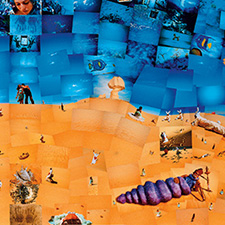
Perspectives: Lara Baladi
August 29, 2015–June 5, 2016
Egyptian-Lebanese artist Lara Baladi (born 1969) experiments with the photographic medium, investigating its history and its role in shaping perceptions of the Middle East—particularly Egypt, where she is based. This installation centers on Oum el Dounia (The Mother of the World), a large-scale tapestry based on a photographic collage. Employing both archival material and Baladi's own images, the work was transformed into a tapestry in 2007 through the use of a digital loom. Oum el Dounia reflects Baladi's interest in the proliferation of images of Egypt, and in how technology and interactivity affect the creation, dissemination, and preservation of visual narratives.

Perspectives: Chiharu Shiota
August 30, 2014–June 7, 2015
Japanese performance and installation artist Chiharu Shiota installs a monumental yet intimate work in the Sackler pavilion this summer. Haunted by the traces that the human body leaves behind, the work amasses personal memories of lost individuals and past moments through an accumulation of discarded shoes and notes collected by the artist. Visit the Sackler pavilion during museum hours between Monday, August 18, and Thursday, August 21, to see Shiota's progress on the installation.
Shiota studied at Kyoto Seika University, Canberra School of Art, and Berlin University of the Arts with Marina Abramovic and Rebecca Horn. Her work has been presented at the Mattress Factory (Pittsburgh, 2013), Birmingham Museum and Art Gallery (United Kingdom, 2012), National Museum of Modern Art, Tokyo (2007), Neue Nationalgalerie (Berlin, 2006), and MoMA PS1 (New York City, 2003), as well as the Biennials in Venice, Fukuoka, and Yokohama. Born in Osaka, Japan, in 1972, Shiota currently lives and works in Berlin.
Gallery »
Shoe Notes »
The Installation »
Turn Your Keys into Art »
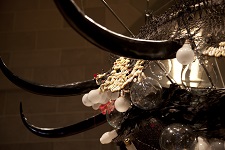
Perspectives: Rina Banerjee
Observable installation: July 9–12, 2013
Exhibition on view: July 13, 2013–June 8, 2014
Sackler
Born in India and based in New York City, artist Rina Banerjee (b. 1963) draws on her background as a scientist and her experience as an immigrant. Her richly textured works complicate the role of objects as representations of cultures and invite viewers to share her fascination in materials. By juxtaposing organic and plastic objects—such as combining ornate textiles and animal forms with tourist souvenirs—she concocts fairytale worlds that are both enticing and subtly menacing. Visitors are invited to view the artist at work July 9–July 12, in advance of the opening.
Touching on themes of migration and transformation, the installation’s lengthy title conveys the sense of a long journey: A World Lost: after the original island, single land mass fractured, after populations migrated, after pollution revealed itself and as cultural locations once separated merged, after the splitting of Adam and Eve, Shiva and Shakti, of race black and white, of culture East and West, after animals diminished, after the seas’ corals did exterminate, after this and at last imagine all water evaporated…this after Columbus found it we lost it imagine this.

Perspectives: Ai Weiwei
May 12, 2012–April 7, 2013
This exhibition features prolific Chinese artist Ai Weiwei’s monumental installation Fragments (2005). Noting the abundance of antique wood on the market, Ai had a number of pieces transported from Guangdong to his studio in Beijing to create a series of objects and installations. Fragments is a culmination of that body of work. Working with a team of skilled carpenters, Ai turned pillars and beams of ironwood (tieli) salvaged from several dismantled Qing dynasty temples into a large-scale, seemingly chaotic work, which he calls an “irrational structure.” Yet examined more closely, one discovers that the installation is an elaborate system of masterful joinery and delicate balance relations. Seen from above, the entire complex is anchored by poles marking out the borders of a map of China. Through his simultaneously destructive and creative process, Ai highlights the bewildering reality that we live in the midst of a world undergoing rapid spatial and social transformations. Perspectives: Ai Weiwei is presented concurrently with Ai Weiwei: According to What? at the Smithsonian’s Hirshhorn Museum and Sculpture Garden.

Perspectives: Minouk Lim
November 19, 2011–March 18, 2012
The Rivers Restoration Project, one of the largest construction projects in South Korea’s history, has elicited considerable debate. In response, Seoul-based artist Minouk Lim staged a performance as the basis of her video The Weight of Hands. Capturing this silent ritual with a thermal imaging camera, Lim questions the effects of dramatic environmental change on the individual’s sense of place and self.

Perspectives: Hale Tenger
July 30–November 6, 2011
Multimedia artist Hale Tenger (born 1960, Izmir, Turkey) creates videos and installations that examine the tangible and intangible traces of events. From 2005 to 2007, Tenger filmed the façade of the St. George Hotel in Beirut—the site of the assassination of Rafik Hariri, former prime minister of Lebanon—while it was being renovated. Gently flapping curtains, shifting light, and Serdar Ateser’s simple musical composition evoke a historical moment with profound repercussions that still haunt this physical space.
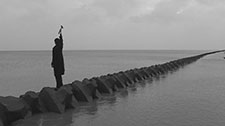
Perspectives: Lu Chunsheng
March 19–July 17, 2011
The 2011 Perspectives series focused on single-projection videos, beginning with History of Chemistry I by Lu Chunsheng (born 1968, Changchun, China), a renowned photographer and video artist now living in Shanghai. A mesmerizing experience of a vaguely familiar but remote world, History of Chemistry I follows a group of men as they wander from somewhere beyond the edge of the sea through a vast landscape to an abandoned steel factory. Using long shots and remote settings, Lu enigmatically refers to a distant history while conveying the sense of dislocation wrought by modernization.

Perspectives: Hai Bo
March 27, 2010–Feburary 27, 2011
The speed and scale of change in contemporary China has been registered by a number of artists exploring the country’s cities and industrial remnants. In stark contrast, Hai Bo (born 1962, Changchun, China) looks to the desolate plains of northeastern China. Trained as a painter, Hai Bo took up photography in the 1980s as he became captivated by the camera’s ability to stop time and evoke memories. He returned to his hometown in Jilin province to capture the people and places of his youth, creating deeply moving portraits of resilience amidst the growing isolation of rural China. Featuring five stunning, large-scale photographs from his Northern Series, this exhibition offered moments to enter the vast panoramas of the artist’s childhood memories, observe the subtle changes of nature across seasons, and encounter the gentle transience of life.
Perspectives: Anish Kapoor
November 22, 2008–February 28, 2010
S-Curve (2006) by internationally renowned Indian sculptor Anish Kapoor consists of two sixteen-foot lengths of polished steel that are gently curved to create a continuous convex and concave wall. The work recalls the exploration of form that Kapoor most famously presented in Cloud Gate in Chicago’s Millennium Park. At a height of seven feet and with highly reflective surfaces, S-Curve engaged viewers in a powerful physical and visual experience within the Sackler Gallery. Known for his sublime approach to pure form, space, and materials since the early 1980s, Kapoor continued to examine spatial perception and the immateriality of the object through this work. [Link to pdf of HK/Asiatica article – 2009]
Perspectives: Y.Z. Kami
March 15–October 13, 2008
Born in Tehran, Y.Z. Kami draws from Eastern and Western aesthetic and mystical traditions to create large-scale works that explore the movement between the physical world and the inward spiritual journey. A student of philosophy, he developed a particular interest in the human face and its relationship to the divine, which has inspired several groups of portraits. This exhibition presented two monumental portraits from his series depicting individuals in meditation. Each subject, rendered with a soft focus and simple palette, emanates a sense of peace and introspection. In the third and largest work on view, poetry and religious architecture also give form to the divine. Using collage and verses from the Massnavi of Jalaluddin Rumi (1207–1273), the artist arranges words like bricks in a spiral of calligraphy that invokes the feeling of looking through a dome or the ecstatic movement of a ritual dance.

Perspectives: Simryn Gill
September 2, 2006–April 29, 2007
This was the first major exhibition in the United States of contemporary artist Simryn Gill (born 1959) and presented three works created between 1992 and 2006. Consisting of poetically transformed found objects, Gill’s works examine relationships among nature, culture, and knowledge. The works reveal a transnational perspective, evocatively referring to passages of material and literary cultures across borders.

Perspectives: Mei-ling Hom
August 27, 2005–March 5, 2006
Floating Mountains, Singing Clouds, a site-specific installation by Chinese-American artist Mei-ling Hom, consisted of 30 cloudlike forms and an original Chinese flute (xiao) composition by American composer Eli Marshall. The hexnet (chicken wire) clouds floated at staggered levels in the carefully lit but darkened space, creating an elusive landscape-in-space that translated traditional Chinese landscape paintings into the contemporary register of installation art.
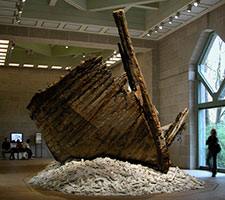
Cai Guo-Qiang—Traveler: Reflection
October 30, 2004–April 24, 2005
Traveler by Chinese artist Cai Guo-Qiang was a two-part exhibition at the Sackler and the Hirshhorn Museum and Sculpture Garden. Reflection, a site-specific installation at the Sackler, invited visitors to ponder the interactions between past and present cultures. The weathered hull of a fishing boat, excavated off the coast of Japan, was installed upon an “ocean” of porcelain fragments of deities from Dehua, China. Exhibited at the same time as China and Iraq, an exhibition that explored the transformative effect of imported luxury Chinese goods on ninth-century Iraqi ceramics, Reflection commented on cultural interaction. The Sackler installation was linked to the Hirshhorn, where Unlucky Year: Unrealized Projects from 2003–2004 presented a selection of Cai’s signature gunpowder drawings.
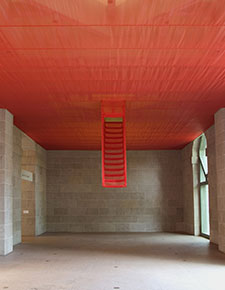
Perspectives: Do-Ho Suh
April 17–September 26, 2004
The fourth in Do-Ho Suh’s series of monumental staircases, Staircase-IV replicated in translucent red nylon fabric the staircase in the artist’s New York apartment in 1:1 scale, complete with architectural detail that created an uncanny sense of the real while transforming density into lightness and the concrete into the remembered. The flight of stairs rose high above the ground to an expansive plateau representing the apartment floor above. Staircase-IV invoked movement, impermanence, and the promise of transcendence along the passage from one level to another.
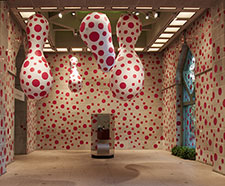
Perspectives: Yayoi Kusama
August 30, 2003–March 21, 2004
The Sackler Gallery inaugurated its program of contemporary installations in the pavilion with two works by the renowned Japanese artist Yayoi Kusama, recognized for her role in post-minimalist and feminist art. The focus on repetition in her work was highlighted with Dots Obsession (1999), an installation composed of six giant white balloons covered with red polka dots that proliferated over the walls of the pavilion. The balloons hovered playfully above Infinity Mirrored Room Love Forever (1996), a hexagonal, mirrored box with an opening into a kaleidoscopic vision of balls and light. By dissolving the pavilion’s surface into pattern, Kusama’s works drew the visitor into a seductive yet unsettling world.
